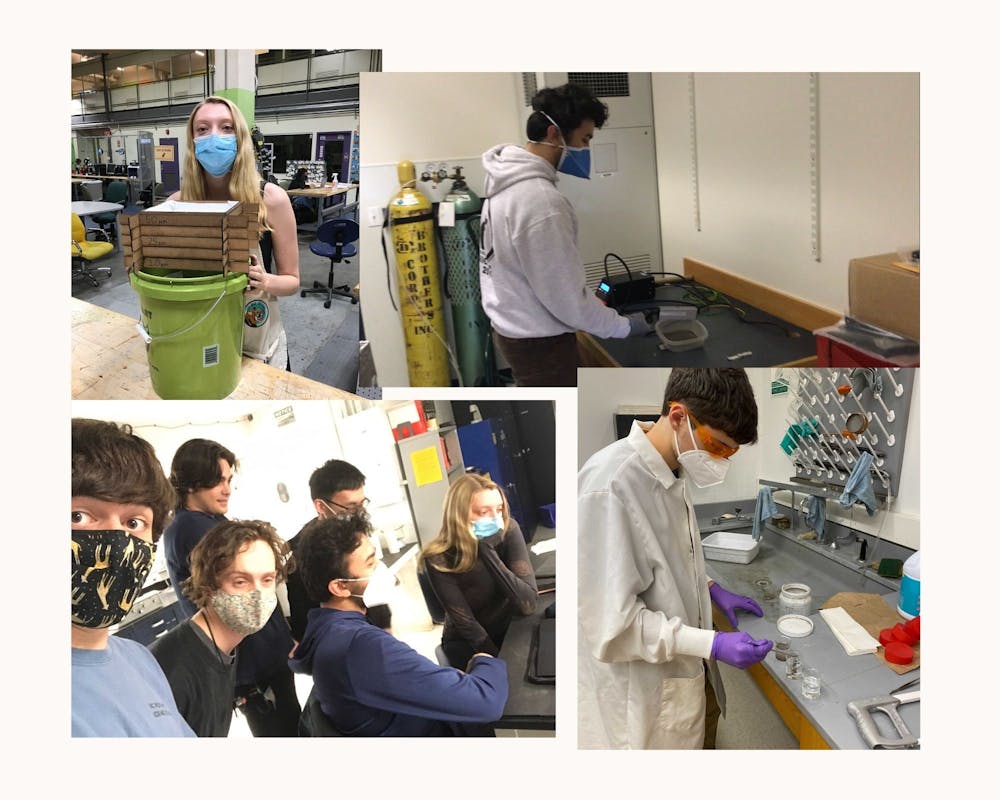A team of students from Brown and the Rhode Island School of Design took home the ‘Most Creative Concept’ award after presenting at NASA’s 2021 Breakthrough, Innovative and Game-changing Idea Challenge last week.
The team was selected as finalists previously in January and were awarded $90,000 to develop concepts and technologies to address the problem of moon dust during space missions. The students virtually presented the final product of the months-long project last Wednesday to a panel of NASA engineers and space experts.
The team’s proposal is called Test-RAD — Tufted Electrostatic Solution to Regolith Adhesion Dilemma — and consists of a hybrid method of passive and active repulsion of moon dust.
Moon dust, also known as regolith, is made up of “a bunch of tiny shards of glass mixed with other minerals,” said Luke Randall ’24, testing lead for the team.
“Because the moon doesn't have an atmosphere and it just has an exosphere, it just stays and floats,” attaching onto objects it comes into contact with, Hannah Skye Dunnigan ’23, design and prototyping lead, added.
Regolith poses a significant hazard to astronauts and their equipment, leading NASA to look for solutions that repel the dust, said Anthony Capobianco ’21, project lead.
The team’s method for passive repulsion, an approach to physically blocking dust, was inspired by biology, specifically by chinchillas. “Chinchillas have such dense fur that you can't get them wet. They have 60 to 80 hairs per follicle, and if you get water on them, the hairs are too dense for the water to escape,” Dunnigan said.
With this information, the team used tufts — fibers densely grouped together in bundles — that “could also conduct static electricity,” Randall said. The static electricity is central to the second part of their solution: active repulsion. Because moon dust is electrically charged by the sun’s radiation out in space, it “levitates and gets everywhere,” he said. “Since like-like charges repel each other, we made these tufts that can carry a static charge” equal to that of the moon dust.
The two-pronged approach ensures that any moon dust that is not repelled by the electrostatic charge will be caught in the dense fibers, keeping dust out of sensitive equipment areas like a seal or joint, Capobianco said.
In the future, Test-RAD would be useful on “ARTEMIS missions, because they plan to land near the lunar South pole,” where the type of moon dust is similar to what the team used in testing, Capobianco said.
The prototype is also more economical than other solutions that were presented, Dunnigan said. “Most of the other solutions are thousands and thousands and thousands of dollars, but ours is $528.74 for the first 10 centimeters, and then $0.24 for each additional centimeter.”
While testing, the team simulated different ways in which the prototype would come into contact with dust on the moon surface. With only electrostatics, the prototype repelled around 40% of the dust cloud, Randall said. After adding passive repulsion, the team observed visually that the prototype was then able to block all dust.
Some technical challenges the students came across included trouble obtaining a vacuum chamber and problems grounding the electricity. “We're testing with voltages of 7,000 volts up to 30,000 volts, so we had to get very well protected gloves and even then, we shocked ourselves continuously,” Randall said.
The Brown-RISD team was the only all-undergraduate team that presented in the BIG Idea Challenge. “Only one person on our entire team was an engineer,” Dunnigan said. While other teams with masters and PhD students had industry partnerships and other resources, the “bulk of Brown students working on this were sophomores and first-years when they first started the project, and some of them started it back in the fall when they weren't even taking classes here,” Capobianco added.
“It was definitely very empowering to (show) that undergrads can do this,” Dunnigan said. As a designer, she noted that she’s also very proud that the team showed that “designers can be in the space as well, not just engineers.”
The team expressed that they were pleased with the results, as they had not expected to be chosen as finalists. “When we initially submitted, we thought it was like one to 100 odds that we got accepted for this crazy, half-baked idea from the moon,” Dunnigan said. “When we first got accepted as finalists, we were all just shocked.”
The team’s faculty advisor Rick Fleeter, adjunct associate professor of engineering, was proud of the team’s professionalism and organization. He said the students presented their work as “a very coherent, linear story,” adding that the students put together the presentation on their own.
The “RISD-Brown connection is a potent combination, and it gets diverse people in the same room trying to solve the problem,” added Christopher Bull, a senior lecturer in engineering and principal investigator of the project.
Receiving the ‘Most Creative Concept’ award is fitting, because Test-RAD “isn't a conventional solution to this type of problem,” said Capobianco, noting the prototype’s unique approach to mimic nature.
“The best idea is an unconventional one,” Dunnigan added.





